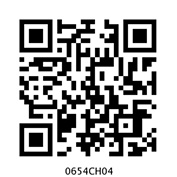Table of Contents
CHAPTER 4
WHAT BOOKS AND BURIALS TELL US
Mary in the library
As the bell rang, the teacher asked the students to follow him, because they were going to the library for the first time. When Mary stepped inside, she found that the library was much larger than their classroom. And there were so many shelves, all full of books. In one corner was a cupboard filled with large, old volumes. Seeing her trying to open the cupboard, the teacher said, “That cupboard has very special books on different religions. Did you know that we have a set of the Vedas?”
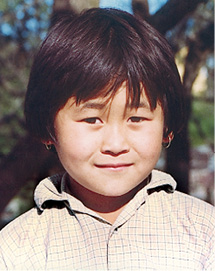
What are the Vedas? Mary wondered. Let us find out.
One of the oldest books in the world
You may have heard about the Vedas. There are four of them – the Rigveda, Samaveda, Yajurveda and Atharvaveda. The oldest Veda is the Rigveda, composed about 3500 years ago. The Rigveda includes more than a thousand hymns, called sukta or “well-said”. These hymns are in praise of various gods and goddesses. Three gods are especially important: Agni, the god of fire; Indra, a warrior god; and Soma, a plant from which a special drink was prepared.
These hymns were composed by sages (rishis). Priests taught students to recite and memorise each syllable, word, and sentence, bit by bit, with great care. Most of the hymns were composed, taught and learnt by men. A few were composed by women. The Rigveda is in old or Vedic Sanskrit, which is different from the Sanskrit you learn in school these days.
Sanskrit and other languages
Sanskrit is part of a family of languages known as Indo-European. Some Indian languages such as Assamese, Gujarati, Hindi, Kashmiri and Sindhi; Asian languages such as Persian and many European languages such as English, French, German, Greek, Italian and Spanish belong to this family. They are called a family because they originally had words in common.
Take the words ‘matr’ (Sanskrit), ‘ma’ (Hindi) and ‘mother’ (English).
Do you notice any similarities?
Other languages used in the subcontinent belong to different families. For instance, those used in the north-east belong to the Tibeto-Burman family; Tamil, Telugu, Kannada and Malayalam belong to the Dravidian family; and the languages spoken in Jharkhand and parts of central India belong to the Austro-Asiatic family.
List the languages you have heard about and try and identify the families to which they belong.
The books we use are written and printed. The Rigveda was recited and heard rather than read. It was written down several centuries after it was first composed, and printed less than 200 years ago.
How historians study the Rigveda
Historians, like archaeologists, find out about the past, but, in addition to material remains, they examine written sources as well. Let us see how they study the Rigveda.
Some of the hymns in the Rigveda are in the form of dialogues. This is part of one such hymn, a dialogue between a sage named Vishvamitra, and two rivers, (Beas and Sutlej) that were worshipped as goddesses.
Find the rivers on Map 1 (page 2), then read on:
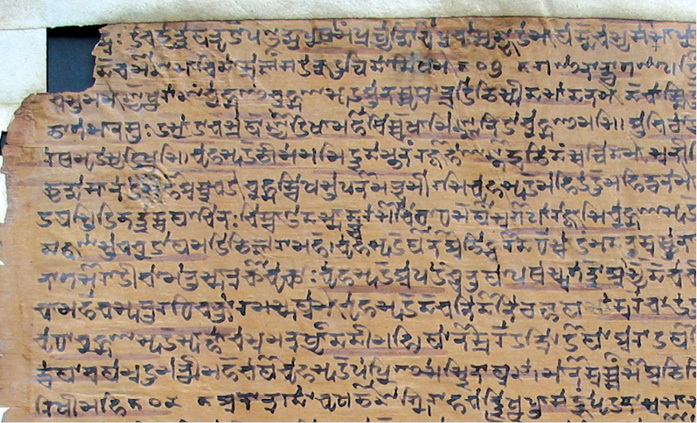
A page from a manuscript of the Rigveda.
This manuscript of the Rigveda, on birch bark, was found in Kashmir. About 150 years ago, it was used to prepare one of the earliest printed texts of the Rigveda, as well as an English translation. It is now preserved in a library in Pune, Maharashtra.
Vishvamitra and the Rivers
Vishvamitra: O rivers, come down from the mountains like two swift horses, like two shining cows that lick their calves.
You move like chariots to the sea, through the power of Indra. You are full of water and wish to unite with one another.
The rivers: We, who are full of water, move along the path the gods have made for us. Once we start flowing, we cannot be stopped. Why do you pray to us, o sage?
Vishvamitra: O sisters, please listen to me, the singer who has come from a distance with his chariots and carts. Let your waters not rise above our axles, so that we can cross safely.
The rivers: We will listen to your prayers so that you can cross safely.
Historians point out that this hymn was composed in the area where these rivers flow. They also suggest that the sage lived in a society where horses and cows were valued animals. That is why the rivers are compared to horses and cows.
Do you think chariots were also important? Give reasons for your answer. Read the verses and find out what are the modes of transport that are mentioned.
Other rivers, especially the Indus and its other tributaries, and the Sarasvati, are also named in the hymns. The Ganga and Yamuna are named only once.
Look at Map 1 (page 2) and list 5 rivers that are not mentioned in the Rigveda.
Cattle, horses and chariots
There are many prayers in the Rigveda for cattle, children (especially sons), and horses. Horses were yoked to chariots that were used in battles, which were fought to capture cattle. Battles were also fought for land, which was important for pasture, and for growing hardy crops that ripened quickly, such as barley. Some battles were fought for water, and to capture people.
Some of the wealth that was obtained was kept by the leaders, some was given to the priests and the rest was distributed amongst the people. Some wealth was used for the performance of yajnas or sacrifices in which offerings were made into the fire. These were meant for gods and goddesses. Offerings could include ghee, grain, and in some cases, animals.
Most men took part in these wars. There was no regular army, but there were assemblies where people met and discussed matters of war and peace. They also chose leaders, who were often brave and skilful warriors.
Words to describe people
There are several ways of describing people — in terms of the work they do, the language they speak, the place they belong to, their family, their communities and cultural practices. Let us see some of the words used to describe people found in the Rigveda.
There are two groups who are described in terms of their work — the priests, sometimes called brahmins, who performed various rituals, and the rajas.
These rajas were not like the ones you will be learning about later. They did not have capital cities, palaces or armies, nor did they collect taxes. Generally, sons did not automatically succeed fathers as rajas.
Read the previous section once more and see whether you can find out what the rajas did.
Two words were used to describe the people or the community as a whole. One was the word jana, which we still use in Hindi and other languages. The other was vish. The word vaishya comes from vish. You will learn more about this in Chapter 5.
Several vish or jana are mentioned by name. So we find reference to the Puru jana or vish, the Bharata jana or vish, the Yadu jana or vish, and so on.
Do any of these names sound familiar?
Sometimes, the people who composed the hymns described themselves as Aryas and called their opponents Dasas or Dasyus. These were people who did not perform sacrifices, and probably spoke different languages. Later, the term dasa (and the feminine dasi) came to mean slave. Slaves were women and men who were often captured in war. They were treated as the property of their owners, who could make them do whatever work they wanted.
While the Rigveda was being composed in the north-west of the subcontinent, there were other developments elsewhere. Let us look at some of these.
Silent sentinels—the story of the megaliths
Look at the illustration on the next page.
These stone boulders are known as megaliths (literally big stones). These were carefully arranged by people, and were used to mark burial sites. The practice of erecting megaliths began about 3000 years ago, and was prevalent throughout
the Deccan, south India, in the north-east and Kashmir.
the Deccan, south India, in the north-east and Kashmir.
Some important megalithic sites are shown on Map 2 (page13). While some megaliths can be seen on the surface, other megalithic burials are often underground.
Sometimes, archaeologists find a circle of stone boulders or a single large stone standing on the ground. These are the only indications that there are burials beneath.
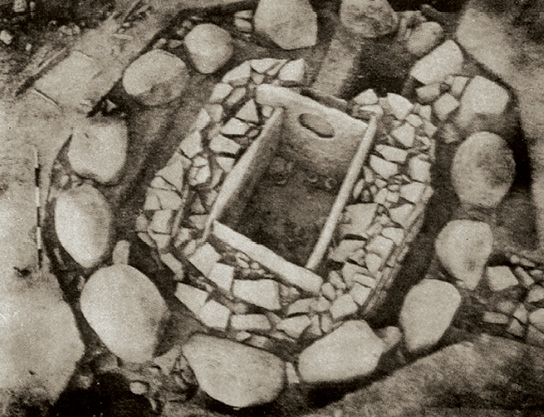
Top : This type of megalith is known as a cist. Some cists, like the one shown here, have port-holes which could be used as an entrance.
There were several things that people did to make megaliths. We have made a list here. Try and arrange them in the correct order: digging pits in the earth, transporting stones, breaking boulders, placing stones in position, finding suitable stone, shaping stones, burying the dead.
All these burials have some common features. Generally, the dead were buried with distinctive pots, which are called Black and Red Ware. Also found are tools and weapons of iron and sometimes, skeletons of horses, horse equipment and ornaments of stone and gold.
Was iron used in the Harappan cities?
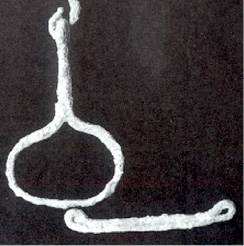
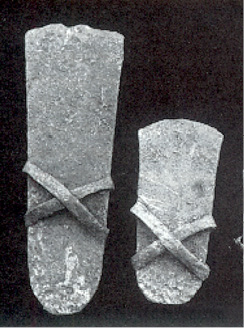
Iron equipment found from megalithic burials.
Left top : Horse equipment.
Left below : Axes.
Below : A dagger.
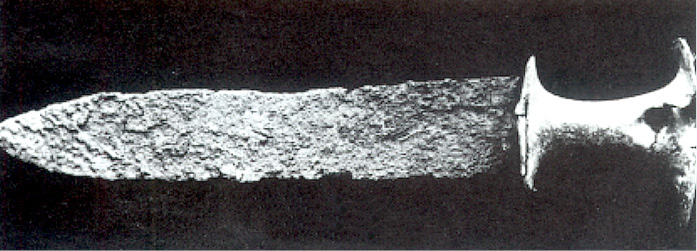
Finding out about social differences
Archaeologists think that objects found with a skeleton probably belonged to the dead person. Sometimes, more objects are found in one grave than in another. Find Brahmagiri on Map 2 (page 13). Here, one skeleton was buried with 33 gold beads, 2 stone beads, 4 copper bangles, and one conch shell. Other skeletons have only a few pots. These finds suggest that there was some difference in status amongst the people who were buried. Some were rich, others poor, some chiefs, others followers.
Were some burial spots meant for certain families?
Sometimes, megaliths contain more than one skeleton. These indicate that people, perhaps belonging to the same family, were buried in the same place though not at the same time. The bodies of those who died later were brought into the grave through the portholes. Stone circles or boulders placed on the surface probably served as signposts to find the burial site, so that people could return to the same place whenever they wanted to.
A special burial at Inamgaon
Find Inamgaon on Map 2 (page13). It is a site on the river Ghod, a tributary of the Bhima. It was occupied between 3600 and 2700 years ago. Here, adults were generally buried in the ground, laid out straight, with the head towards the north. Sometimes burials were within the houses. Vessels that probably contained food and water were placed with the dead.
One man was found buried in a large, four legged clay jar in the courtyard of a five-roomed house (one of the largest houses at the site), in the centre of the settlement. This house also had a granary. The body was placed in a cross-legged position.
Do you think this was the body of a chief? Give reasons for your answer.
What skeletal studies tell us
It is easy to make out the skeleton of a child from its small size. However, there are no major differences in the bones of a girl and a boy.
Can we make out whether a skeleton was that of a man or a woman?
Sometimes, people decide on the basis of what is found with the skeleton. For instance, if a skeleton is found with jewellery, it is sometimes thought to be that of a woman. However, there are problems with this. Often, men also wore ornaments.
A better way of figuring out the sex of a skeleton is to look at the bone structure. The hip or the pelvic area of women is generally larger to enable child bearing.
These distinctions are based on modern skeletal studies.
About 2000 years ago, there was a famous physician named Charaka who wrote a book on medicine known as the Charaka Samhita. There he states that the human body has 360 bones. This is a much larger number than the 200 bones that are recognised in modern anatomy. Charaka arrived at this figure by counting the teeth, joints and cartilage.
How do you think he found out about the human body in such great detail?
Occupations at Inamgaon
Archaeologists have found seeds of wheat, barley, rice, pulses, millets, peas and sesame. Bones of a number of animals, many bearing cut marks that show they may have been used as food, have also been found. These include cattle, buffalo, goat, sheep, dog, horse, ass, pig, sambhar, spotted deer, blackbuck, antelope, hare, and mongoose, besides birds, crocodile, turtle, crab and fish. There is evidence that fruits such as ber, amla, jamun, dates and a variety of berries were collected.
Use this evidence to list the possible occupations of the people at Inamgaon.
Elsewhere
Find China in your atlas. Around 3500 years ago, we find some of the first evidence of writing in China.
These writings were on animal bones. These are called oracle bones, because they were used to predict the future. Kings got scribes to write questions on the bones — would they win battles? Would the harvest be good? Would they have sons? The bones were then put into the fire, and they cracked because of the heat. Then fortunetellers studied these cracks, and tried to predict the future. As you may expect, they sometimes made mistakes.
These kings lived in palaces in cities. They amassed vast quantities of wealth, including large, elaborately decorated bronze vessels. However, they did not know the use of iron.
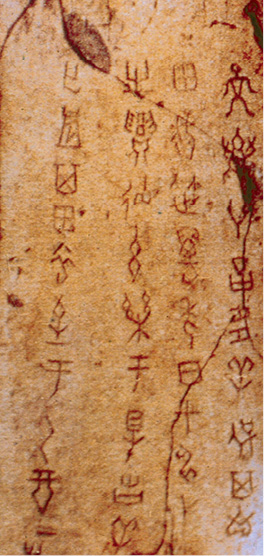
List one difference between the raja of the Rigveda and these kings.
Imagine
You live in Inamgaon, 3000 years ago, and the chief has died last night. Today, your parents are preparing for the burial. Describe the scene, including how food is being prepared for the funeral. What do you think would be offered?
Keywords
Veda
language
hymn
chariot
sacrifice
raja
slave
megalith
burial
skeletal
iron
Some Important Dates
- Beginning of the composition of the Vedas (about 3500 years ago)
- Beginning of the building of megaliths (about 3000 years ago)
- Settlement at Inamgaon (between 3600 and 2700 years ago)
- Charaka (about 2000 years ago)
Let’s recall
1. Match the columns
| Sukta | Stone boulder |
| Chariots | Sacrifice |
| Yajna | Well-said |
| Dasa | Used in battles |
| Megalith | Slave |
2. Complete the sentences:
(a) Slaves were used for ————————
(b) Megaliths are found in ————————
(c) Stone circles or boulders on the surface were used to ————————
(d) Port-holes were used for ————————
(e) People at Inamgaon ate ————————
Let’s discuss
3. In what ways are the books we read today different from the Rigveda?
4. What kind of evidence from burials do archaeologists use to find out whether there were social differences amongst those who were buried?
5. In what ways do you think that the life of a raja was different from that of a dasa or dasi?
Let’s do
6. Find out whether your school library has a collection of books on religion, and list the names of five books from this collection.
7. Write down a short poem or song that you have memorised. Did you hear or read the poem or song? How did you learn it by heart?
8. In the Rigveda, people were described in terms of the work they did and the languages they spoke. In the table below, fill in the names of six people you know, choosing three men and three women. For each of them, mention the work they do and the language they speak. Would you like to add anything else to the description?
| NAME | WORK | LANGUAGE | ANYTHING ELSE |
